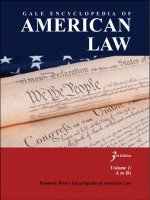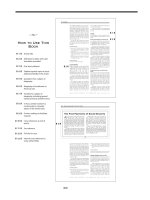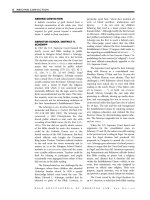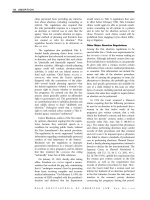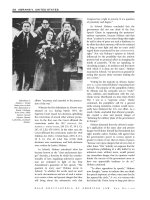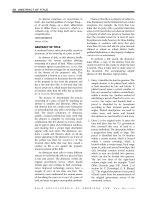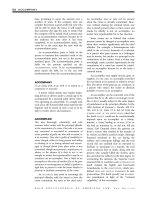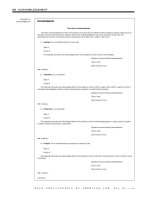Gale Encyclopedia Of American Law 3Rd Edition Volume 1 P28 docx
Bạn đang xem bản rút gọn của tài liệu. Xem và tải ngay bản đầy đủ của tài liệu tại đây (198.14 KB, 10 trang )
ambiguity deprives a person of the notice
requirement of DUE PROCESS OF LAW, and, therefore,
renders the statute unconstitutional.
AMBIT
A boundary line that indicates ownership of a
parcel of land as opposed to other parcels; an
exterior or enclosing line. The limits of a power or
jurisdiction. The delineation of the scope of a
particular subject matter.
AMBULANCE CHASER
A colloquial phrase that is used derisively for a
person who is hired by an attorney to seek out
NEGLIGENCE cases at the scenes of accidents or in
hospitals where injured parties are treated, in
exchange for a percenta ge of the damages that will
be recovered in the case.
Also used to describe attorneys who, upon
learning of a personal injury that might have been
caused by the negligence or the wrongful act of
another, immediately contact the v ictim for consent to
represent h im or her in a lawsuit in exchange for a
contingent fee, a percentage of the judgment recovered.
AMBULATORY
Movable; revocable; subject to change; capable of
alteration.
An ambulatory court was the former name
of the Court of King’s Bench in England. It
would convene wherever the king who presided
over it could be found, moving its location as
the king moved.
An ambulatory disposition is a judgment,
DECREE, or sentence that is subject to change,
amendment, or revocation.
A will is considered ambulatory because as
long as the person who made it lives, it can
always be changed or revoked.
AMENDMENT
The modification of materials by the addition of
supplemental information; the deletion of unnec-
essary, undesirable, or outdated information; or
the correction of errors existing in the text.
In practice, a change in the pleadings—
statements of the allegations of t he parties i n a
lawsuit—may be achieved if the parties agree to the
amendment or if the court in which the proceed-
ing is pending grants a motion for the amendment
made by one party. A judgment may be a ltered
by an amendment if a motion to do so is made
within a certain time after its entry and granted by
the c ourt. The amendment of pleadings and
judgments is regulated by state codes of
CIVIL
PROCEDURE
and the rules of federal civil procedure.
A constitution or a statute may be changed
by an amendment.
A will, trust, corporate charter, and other
legal documents are also subject to amendment.
CROSS REFERENCE
Constitutional Amendment.
AMERICAN ASSOCIATION FOR
JUSTICE
The American Association for Justice (AAJ)
(formerly the Association of Trial Lawyers of
America, or ATLA) is a
NONPROFIT organization
that represents the interests of
PERSONAL INJURY
attorneys. The AAJ is the world’slargesttrialbar
organization, with more t han 5 6,000 members
worldwide. AAJ’s goals are to safeguard the
interests of p eople who seek redress for injury
and to protect individuals from abuses of power.
Any person who is licensed to practice law in any
country, state, or jurisdiction, who is committed to
the
ADVERSARY SYSTEM, and who, for the most part,
does not represent the defense in personal injury
LITIGATION is eligible for membership. In 1946, a
group of plaintiffs’ attorneys involved in workers’
compensations litigation founded the National
Association of Claimants’
COMPENSATION Attorneys
(NCACCA). In 1972 NACCA b ecame ATLA, a nd
in 1977, the organization moved its headquarters
from Boston to Washington, D.C. The association
changed its name once again in 2006 to the AAJ.
AAJ comprises a network of U.S. and
Canadian affiliates involved in diverse areas of
trial advo cacy. It provides lawyers with the
information and professional assistance needed
to serve clients successfully and protect the civil
justice system. AAJ is governed by its member-
ship through a board of governors and national
officers who are elected at the organization’s
annual convention. AAJ committees help to
setpoliciesincriticalareas,makerecommen-
dations to the board of governors, and oversee
staff implementation of AAJ objectives. The
AAJ h as 155 staff members, including approxi-
mately 30 attorneys. It publishes the monthly
magazine Trial, AAJ Law Reporter,andAAJ
Advocate.
AAJ’s sections, each of which encompasses an
area of litigation practice, include admiralty,
GALE ENCYCLOPEDIA OF AMERICAN LAW, 3RD E DITION
258 AMBIT
aviation, CIVIL RIGHTS, products LIABILITY, insur-
ance, FAMILY LAW, and workers’ compensation
law. Services of the sections include the publica-
tion of annual directories and periodic news-
letters and information exchange. AAJ also has
organized litigation groups, which are voluntary
networks of AAJ members sharing an interest in a
particular type of case, many of which involve
hazardous products. The groups share timely
documents and information, much of it obtained
from discovery in similar cases. The litigation
groups organize programs that educate members
about recent developments in their special areas.
AAJ has been a leading opponent of state and
federal legislative efforts to restrict the amount of
DAMAGES a PLAINTIFF can recover for MEDICAL
MALPRACTICE
or for injuries caused by a defective
product. Two major areas of litigation that
emerged during the early 200 0s were related to
asbestos and toxic mold. For many years, the
organization has lobbied against tort reform bills,
rebutting arguments that too many lawsuits have
led to excessive costs and delays and that juries
can no longer be trusted to render fair verdicts.
The election of
GEORGE W. BUSH as president in
2000 and the gain of Republican seats in
both the House and Senate in 2002 brought the
issue to the forefront. Although some commen-
tators expected a significant number of states to
approve tort reform measures, the proposals in
most of these states failed. As Democrats regained
control of Congress during the mid- to late-
2000s, focus on the tort reform issue became less
intense. Tort reform was not a major issue during
the presidential campaign of 2008.
In addition to its
LOBBYING efforts, AAJ
provides a special ization certification program
for trial skills and statistical compilation, as well
as a placement service. It al so conducts seminars
and conferences across the country.
During the 2000s, members of the ATLA
expressed concern about negative reactions to
the reference to trial lawyers in the association’s
name. In 2006 the members agreed to change the
name to the American Association for Justice.
Membership is not limited to trial lawyers and
instead extends to attorneys, law professors,
paralegals, and law students.
Web site:
FURTHER READINGS
American Association for Justice. Available online at http://
www.justice.org (accessed May 12, 2009).
Bogus, Carl T. 2001. Why Lawsuits Are Good for America:
Disciplined Democracy, Big Business, and the Common
Law. New York: New York Univ. Press.
Orey, Michael. 1999. Assuming the Risk: The Mavericks, the
Lawyers, and the Whistle-Blowers Who Beat Big Tobacco.
Boston: Little, Brown.
AMERICAN ASSOCIATION OF
RETIRED PERSONS
The American Association of Retired Persons
(AARP) is a
NONPROFIT, nonpartisan organization
dedicated to helping older Amer icans achieve
lives of independence, dignity, and purpose.
Founded in 1958 by Dr. Ethel Percy Andrus,
AARP is the oldest and largest organization of
older Americans, with a membership of 40
million. The National Retired Teachers Associa-
tion (NTRA), which was founded in 1947, is a
division of AARP. Membership in AARP is open
to anyone age 50 or older, working or retire d.
More than one-third of the association’s mem-
bership is in the workforce. The AARP head-
quarters are in Washington, D.C. By the early
2000s, AARP had fulfilled its goal of having
staffed offices in all 50 states, as well as the
District of Columbia, Puerto Rico, and the U.S.
Virgin Islands. AARP has an extensive network of
local AARP chapters, its National Community
Service Programs and NTRA members to involve
members, volunteers, the media, community
partners, and policymakers in carrying out
its objectives. The organization is led by a
21-member
BOARD OF DIRECTORS and has an
administrative staff that carries out the group’s
day-to-day activities. The organization is funded
almost entirely by annual membership dues.
The AARP has been an effective advocate for
issues involving older persons, in part because
of its large membership and its ability to
mobilize its members to lobby for its positions
before Congress and government agencies. The
organization has concentrated much of its
LOBBYING effort on SOCIAL SECURITY, MEDICARE, and
long-term care issues. The AARP has fought
zealously to protect the Social Security benefits of
retired citizens and has resisted efforts by
Congress to change the system itself. Its Advocacy
Center for Social Security develop s policy
proposals and lobbies Congress.
The AARP Advocacy Center for Medicare
seeks to ensure the availability of affordable,
quality health care for older individuals and
persons with disabilities. In the early 2000s,
it worked to develop ways of maintaining the
GALE ENCYCLOPEDIA OF AMERICAN LAW, 3RD E DITION
AMERICAN ASSOCIATION OF RETIRED PERSONS 259
short-term SOLVENCY of the Hospital Insurance
Trust Fund and was preparing for the long-term
needs of the aging baby boom ers. With the
dramatic growth in managed health care plans,
the AARP has sought to educate its members
about this new way of providing services and to
empower older people by telling them what their
rights are under this system. However, AARP lost
a significant and protracted court battle in 2008
when the U.S. Supreme Court denied review of
the AARP challenge to a proposed rule from the
EQUAL EMPLOYMENT OPPORTUNITY COMMISSION
(EEOC), which created a new exemption to the
AGE DISCRIMINATION in Employment Act (ADEA)
(AARP v. EEOC, 2008 WL 754343, ___ U.S. ___
[2008]). The new exemption allows employers to
reduce retiree health benefits for anyone 65 or
older (i.e., eligible for Medicare). The Third
CIRCUIT COURT of Appeals sided with EEOC in
finding that Congress had delegated to the EEOC
complete authority to create exemptions under
ADEA (AARP v. EEOC, 489 F.3d 558 [3rd Cir.
2008]).
The association also has been actively
involved in voter education. A major, nonparti-
san component of the association’s legislative
program is AARP/VOTE, a voter education
program designed to inform the public about
important
PUBLIC POLICY issues and the positions
of candidates for public office. Through issue
and candidate forums and voter guides, AARP/
VOTE works to promote issue-centered cam-
paigns and a more informed electorate.
The organization also provides many benefits
to its members. The AARP licenses the use of its
name for sele cted services of chosen providers.
For example, it offers members a choice of
insurance plans. Because most of the plans are
neither age-rated nor medically underwritten,
the association can make
HEALTH INSURANCE
available to many of its members who otherwise
would be unable to obtain coverage because of
pre-existing conditions. The association receives
an administrative allowance or a roya lty from the
providers and the income realized from these
services is used for the general purposes of the
association and its members.
AARP operates a nationwide volunteer net-
work that helps older citizens. Programs include
information and support for grandparents who
are raising their grandchildren, legal hotlines,
and
INCOME TAX preparation. These and other
programs are funded, in part, by federal grants.
The association produces two national radio
network series and publishes a monthly maga-
zine, AARP The Magazine; a monthly newspaper,
the AARP Bulletin; and a quarterly Spanish-
language newspaper, Segunda Jeventud. As older
adults have gained computer skills, the organiza-
tion’s Web site has become increasingly popular.
Outreach programs launched by AARP in the
early 2000s include a collaborative national effort
to help prepare people for independent living,
long-term care, and end-of-life care, as well as a
pilot program to promote physical activities for
healthy aging.
FURTHER READINGS
American Association of Retired Persons. Available online at
www.aarp.org (accessed September 26, 2009).
Kimbol, Anne. 2008. “Medicare and Retiree Benefits: The
Impact of AARP v. EEOC.” Health Law Perspectives,
University of Houston Law Center, April 2008. Text
available online at />perspectives/homepage.asp; website home page: http://
www.law.uh.edu/ (accessed August 5, 2009)
Morris, Charles R. 1996. The AARP: America’s Most Powerful
Lobby and the Clash of Generations. New York: Times
Books.
Van Atta, Dale. 1998. Trust Betrayed: Inside the AARP.
Chicago: Regnery.
CROSS REFERENCES
Age Discrimination; Elder Law; Senior Citizens; Senior
Citizens: How to Avoid Being Defrauded; Senior Citizens
“Scamming the Elderly” (In Focus).
AMERICAN BANKERS ASSOCIATION
The American Bankers Association (ABA) is
composed of banks and other financial institu-
tions. It seeks to promote the strength and
profitability of the banking industry by
LOBBYING
federal and state governments, building industry
consensus on key issues, and providing products
and services, including public affairs support and
legal services, to its member banks. Membership
in the ABA includes community, regional, and
money-center banks (the nation’s major banks)
and holding companies, as well as savings
associations, trust companies , and savings banks.
The ABA, which was founded in 1875, is the
largest banking trade association in the United
States. The organization includes more than 95
percent of the commercial banking industry as
members. As of 2009 these members employ
more than two million people and have more
than $13 trillion in assets. The ABA’s headquar-
ters are in Washington, D.C.
GALE ENCYCLOPEDIA OF AMERICAN LAW, 3RD E DITION
260 AMERICAN BANKERS ASSOCIATION
The ABA places great emphasis on represent-
ing the interests of banks before Congress and
state legislatures. The association takes stands on
banking and bank-related bills as they move
through Congress, attempts to influence the
interpretations of laws and regulations by
banking regulators, and is actively involved in
state
LITIGATION that has implications for the
banking industry. Throughout the 1990s and
2000s, ABA representatives frequently testified
before Congress, filed official letters of commen t,
and sponsored trips by state associations to the
nation’s capital. During this time, BankPac, the
banking industry’s
POLITICAL ACTION COMMITTEE
and one of the strongest committees nationwide,
raised and distributed millions of dollars for
congressional elections. The ABA fought legisla-
tive effor ts to regulate the fees banks charge
customers to use automated teller machines
(ATM) and has challenged in court the member-
ship policies used by credit unions to gain
customers. ABA also became involved in suc h
issues as ATM accessibility for blind persons,
predatory lending practices,
SOCIAL SECURITY
reform, and MONEY LAUNDERING.
In 2001 the ABA established the ABA
Mortgage Solutions program, which assists mem-
ber banks in the secondary mortgage market.
When a lender initially makes a loan, it has a
choice to keep the loan as part of its portfolio or to
sell the loan on the secondary mortgage market.
The ABA’s program became the most widely used
in the banking industry. By 2009, the total amount
of mortgages sold through this program surpassed
$100 billion. Several major banks and organiza-
tions are involved in this program, including the
Federal Home Loan Mortgage Corporation
(Freddie Mac) and
FEDERAL NATIONAL MORTGAGE
ASSOCIATION
(Fannie Mae).
The ABA operates the American Institute for
Banking (AIB), which is the largest provider of
banking education. The AIB teaches more than
100,000 students annually. In addition, the ABA
sponsors approximately 24 residential schools
with 3,700 students covering specialty areas within
banking and the prestigious Stonier Graduate
School of Banking. New technology has provided
new opportunities as well. American Financial
Skylink is a satellite
TELECOMMUNICATIONS network
that delivers news, information, and training
directly to banks through regular telecasts.
Other ABA affiliates include the following:
ABA eCom, which facilitates electronic banking
and
COMMERCE over the INTERNET; the ABA
Education Foundation, which provides resources
for consumer education; and the ABA Marketing
Network (ABAMN), which informs and educates
banks in the marketing of their products and
services. The ABA
SECURITIES Association assists
sections of the banking industry that are
competing in the securities business.
Since the early twentieth century the ABA
has produced the ABA Banking Journal,a
monthly magazine that focuses on news and
analysis of the financial services industry. The
journal is published for the ABA by Simmons-
Boardman Publishing Corp.
Though the ABA is a
NONPROFIT organization,
it operates the for-profit Corporation for Ameri-
can Banking (CAB). CAB was created to facilitate
group buying of services, allowing participating
banks to receive CAB-arranged discounts on long-
distance telephone service, overnight package
delivery, office products, and copying products.
FURTHER READINGS
ABA Banking Journal. Available online at bj.
com/ (accessed May 3, 2009).
American Bankers Association. Available online at http://
www.aba.com (accessed May 3, 2009).
Lovett, William A. 2005. Banking & Financial Institutions
Law in a Nutshell, 6th ed. St. Paul, MN: Thomson/
West.
Malloy, Michael A. 2003. Principles of Banking Regulation,2d
ed. St. Paul, MN: West Group.
AMERICAN BAR ASSOCIATION
The American Bar Association (ABA) is a
nationwide organiz ation to which qualified
attorneys voluntarily belong. With more than
413,000 members, the ABA is the largest volun-
tary professional organization in the world.
The ABA was founded in 1878 to improve
LEGAL EDUCATION, to set requirements to be
satisfied for admittance to the bar, and to
facilitate the exchange of ideas and information
among its members. Over the years, the ABA has
been largely responsible for the further develop-
ment of American jurisprudence; the establish-
ment of formal education requirements for
persons seeking to become attorneys; the formu-
lation of ethical principles that govern the
PRACTICE OF LAW; and the creation of the American
Law Institute (ALI) and the Conference of
Commissioners on Uniform State Laws, both of
which advance the fair administration of justice
through encouraging uniformity of statutes and
GALE ENCYCLOPEDIA OF AMERICAN LAW, 3RD E DITION
AMERICAN BAR ASSOCIATION 261
judicial decisions whenever practicable. For
several years, the ABA has been prominently
involved in the recommendation and selection of
candidates for the federal
JUDICIARY, the accredi-
tation of law schools, and the refinement of rules
of legal and judicial ethics.
Applicants for membership in the ABA
must meet certain criteria. They must be
members in good standing of the bar of a state,
TERRITORY, or possession of the United States.
They must also have good moral character and
pay the designated dues. Law students qualify to
be members of the Law Student Division of the
ABA if they attend an ABA-approved law school
and pay the specified dues. The ABA continues
to put great emphasis on promoting diversity
within its membership and has initiated several
programs designed to bring more women and
racial and ethnic minorities into the profession.
The ABA provides various forums through
which attorneys continue their legal education
during their careers. The association’s national
institutes are held frequently in areas of law that
have become topical or have undergone sweep-
ing reform. In conjunction with the ALI, the
ABA holds seminars in order to continue the
professional education of interested members.
Within the ABA, members may participate in
the activities of numerous sections, which range
in size from about 2,300 members to more than
70,000 and are organized according to specialized
areas of law. Various committees exist that deal
with such topics as judicial selection,
PROFESSIONAL
RESPONSIBILITY
and discipline, lawyer referral
services, and the
UNAUTHORIZED PRACTICE of law.
Other committees are concerned with topical
areas, such as prepaid legal services,
MALPRACTICE,
legal problems of the elderly, and public-interest
law. The ABA employs more than 750 profes-
sional staff members to assist committees,
sections, and individual members.
The ABA is involved in the political process
through its seven-person Governmental Affairs
Office (GAO), a
LOBBYING effort that serves as
the “eyes, ears and voice” of the organized bar at
the seat of the national government in
Washington, D.C. The GAO staff is housed
with about 170 other ABA staffers in the ABA’s
Washington, D.C. office. (The ABA’s main
offices are in Chicago, with more than 500 staff
members.) The lobbying group in Washington,
D.C., headed by the ABA ’s associate executive
director, testifies on Capitol Hill more of ten
than any other trade association. The ABA’s
lobbyists offer detailed information and analysis
on various technical issues, such as tax or
antitrust legislation. On issues such as
ABORTION,
which many ABA members and leaders consider
as having an
EFFECT on the legal system, the
ABA offers its voice along with those of other
interested groups.
Another influential ABA committee is the
Standing Committee on the Federal Judiciary.
This committee consists of 15 members, includ-
ing one representative for each federal circuit,
two representatives for the Ninth Circuit, and
one at-large member. The President of ABA
selects members based on professional compe-
tence, integrity, and devotion to public service.
The committee rates each judicial nominee as
“well qualified,”“qualified,” or “not qualified.”
The committee lists these ratings with the initials
WQ, Q, and NQ. For example, when President
GEORGE W. BUSH nominated JOHN ROBERTS to serve
as Chief Justice of the Supreme Court in 2005, the
ABA committee rated Roberts as WQ.
Equal access for all to the justice system has
become an increasingly important theme in the
ABA’s mission. The association has sought for a
number of years to increase and improve free
legal services to needy persons by practicing
lawyers. These lawyers donate some of their
work
PRO BONO publico (for the good of the
public). In 1981, the ABA created the Private
Bar Involvement Project, now called the Pro
Bono Project, which acts as a national clearing-
house of information and resources for various
pro bono programs around the United States.
When it began, there were 66 organized projects
nationwide; by 1995 there were more than 950.
The ABA actively supports several major
legislative priorities on topics that have been in
the forefront of American political and govern-
mental affairs. The ABA has called for a
MORATORIUM on the death PENALTY until certain
procedures and policies are put into effect that
mandate fair and
IMPARTIAL administration of
CAPITAL PUNISHMENT. The Death Penalty Morato-
rium Implementation Project had produced a
number of reports focusing on specific states,
including California, Maryland, New Jersey, and
Illinois. These reports typically demonstrate
flaws in capital punishment procedures used
in those states.
Since the
SEPTEMBER 11TH ATTACKS in 2001,
the ABA has stepped up its opposition to laws
GALE ENCYCLOPEDIA OF AMERICAN LAW, 3RD E DITION
262 AMERICAN BAR ASSOCIATION
requiring extra verification of citizenship for
immigrants. Additionally, the ABA has urged that
U.S. citizens and legal residents detained as
“enemy combatants” be afforded due process
rights and that military tribunals authorized to
conduct trials of suspected terrorists be used in
limited circumstances. The ABA has also an-
nounced its opposition to the incommunicado
DETENTION of nationals held in undisclosed loca-
tions by
IMMIGRATION officials or the HOMELAND
SECURITY DEPARTMENT
. The ABA continued to
PROTEST detentions of nationals in such locations
as Guantanamo Bay during the early 2000s.
The ABA holds annual conventions and
midyear meetings to discuss designated legal
topics and ABA matters. It publishes the monthly
American
BAR ASSOCIATION Journal , an annual
directory, and various journals and newsletters
reporting the work of its sections and commit-
tees. The ABA also supports the activities of
affiliated organizations, such as the American
Bar Foundation, which sponsors research activi-
ties in law.
The ABA provides a social outlet for its
members through which members meet to
freely exchange ideas and experiences that add
to the human dimension in the practice of law.
The ABA has eleven goals:
1. Promote improvement in the U .S. system
of justice
2. Promote meaningful access to
LEGAL REPRE-
SENTATION
and th e U.S. system of justice
for all persons regardless of their econom-
ic or social condition
3. Provide ongoing leadership in improving
the law to serve the changing needs of
society
4. Increase public unders tanding of and
respect for the law, the legal process, and
theroleofthelegalprofession
5. Achieve the highest standards of profession-
alism, competence, and ethical conduct
6. Serve as the national representative of the
legal profession
7. Provide benefits, programs, and services
that promote professional growth and
enhance the quality of life of the members
8. Advance the rule of law in the world
9. Promote full and equal participation in the
legal profession by members of minorities
and women
10.Preserveandenhancetheidealsofthelegal
profession as a common calling and its
dedication to public service
11. Preserve the independence of the legal
profession and the judiciary as fundamen-
tal to a free society
FURTHER READINGS
ABA Standing Committee on the Judiciary. Available online
at />American Bar Association Website. Available online at http://
www.abanet.org/home.html (accessed May 11, 2009).
Hobson, Wayne K. 1986. The American Legal Profession and the
Organizational Society, 1890–1930. New York: Garland.
AMERICAN CIVIL LIBERTIES UNION
Since 1920 the American Civil Liberties Union
(ACLU) has fought energetically for the rights
of individuals. This private, nonprofit organiza-
tion is a multipurpose legal group with 300,000
members committed to the freedoms in the
Bill of Rights. Although these liberties—such
as free speech, equality, due process, privacy—
are guaranteed to each citizen, they are never
completely secure. Governments and majorities
can easily weaken them or even take them away.
The ACLU has had enormous success fighting
such cases: Many of the most important
Supreme Court decisions have been won with
its involvement, and the ACLU continues to
fight thousands of lawsuits in state and federal
courts each year. The ACLU also lobbies
lawmakers and speaks out on a wide variety of
civil liberties and civil rights issues. Its devotion
to these concerns makes it highly controversial.
The origins of the ACLU date to
WORLD WAR I,
a dark era for civil liberties. War fever gripped the
United States, and official hostility toward
DISSENT
ran high. Attorney General A. MITCHELL PALMER
orchestrated much of this hostility from
Washington, D.C., by ordering crackdowns on
protesters, breaking strikes, prosecuting consci-
entious objectors, and deporting thousands of
immigrants. One group in particular stood up to
him: the American Union against Militarism
(AUAM), led by social reformers and radicals.
Among its founder s was the pacifist
ROGER
BALDWIN
, a former sociology teacher. In 1917, as
the United Stat es prepared to enter the war,
Baldwin gave the group a broader mission by
transforming it into the Civil Liberties Bureau,
dedicated to the defense of those the government
saw fit to crush and corral. Anti-Communist
hysteria worsened the civil liberties picture
GALE ENCYCLOPEDIA OF AMERICAN LAW, 3RD E DITION
AMERICAN CIVIL LIBERTIES UNION 263
between 1919 and 1920, and the upstart bureau
had its hands full as Palmer, and his assist ant,
J. EDGAR HOOVER, staged massive police raids that
netted thousands of alleged subversives at a time.
In 1920 the Civil Liberties Bureau became
the ACLU. Joining Baldwin in launching the
new organization were several distinguished
social leaders, including the author Helen
A. Keller, the attorney and future Supreme
Court Justice
FELIX FRANKFURTER, and the socialist
clergyman Norman Thomas. The ACLU quickly
joined the U.S. Congress and the
AMERICAN BAR
ASSOCIATION
in denouncing Attorney General
Palmer for his raids—and the outcry helped end
his tyrannical career. In the first annual ACLU
report, Baldwin weighed the effectiveness of
public activism, noting, “[T]he mere public
assertion of the principle of freedom helps
win it recognition, and in the long run makes
for tolerance and against resort to violence.” In
its weekly “Report on Civil Liberties Situation,”
the group watched over a torrent of abuses: a
mob forcing a Farmer-Labor party delegation in
Washington State to salute the U.S. flag; a
Russian chemist being arrested in Illinois for
distributing “inflammatory” handbills; and the
LYNCHING and burning of six black men in
Florida after a black man attempted to vote.pi tp
From the beginning, strict political neutral-
ity was the ACLU rule. The group did not
oppose political candidates and declared itself
neither liberal nor conservative. This position
had an important consequence: The ACLU
would defend the civil liberties of all people,
including those who were weak, unpopular, and
despised, without respect to their views. This
principle made for strange bedfellows. The
Boston Globe recalled the following in its eulogy
for Baldwin:
[A]t one point Mr. Baldwin was engaged
simultaneously in defending the rights of the
KU KLUX KLAN to hold meetings in Boston,
despite the orders of a Catholic mayor; of
Catholic teachers to teach in the schools of
Akron, despite the opposition of the Ku Klux
Klan; and of Communists to exhibit their
film, “The Fifth Year,” in Providence, despite
the opposition of both the Catholics and the
Ku Klux Klan.
Consequently, while carving out a unique
place for the ACLU in U.S. law, these defenses
also won the organization enemies.
Within a few years, the ACLU was widely
known. Its first victory before the Supreme Court
came in the landmark 1925 case Gitlow v. New
York (268 U.S. 652, 45 S. Ct. 625, 69 L. Ed. 1138),
in which the Court threw out the defendant’s
CONVICTION under New York’s “criminal anar-
chy” statute (N.Y. Penal Law §§ 160, 161, Laws
1909, ch. 88; Consol. Laws 1909, ch. 40), for
advocating the overthrow of the U.S. government
in a printed flyer. Gitlow established that the
FOURTEENTH AMENDMENT, which applies to the
states, includes
FREEDOM OF SPEECH in its liberty
guarantee. By 1926 the ACLU was involved in
the debate over church-state separation. It joined
the so-called
SCOPES MONKEY TRIAL, arguing against
a Tennessee law that forbade teaching the theory
of evolution in public schools (Scopes v. State, 152
Tenn. 424, 278 S.W. 57 [1925]; 154 Tenn. 105,
289 S.W. 363 [1927]). Besides bringing the group
to natio nal and worldwide attention, Scopes set it
on a course from which it never veered: fighting
government interference in religious matters. It
staged this fight with equanimity, opposing
official help and hindrance to
RELIGION, and it
soon backed the Jehovah’s Witnesses in a series of
key Supreme Court cases. This involvement laid
the groundwork for the Supreme Court’s ruling,
in a 1962 challenge originally brought by the
ACLU, that school
PRAYER is unconstitutional
ENGEL V. VITALE, 370 U.S. 421, 82 S. Ct. 1261, 8 L.
Ed. 2d 601).
Between the 1930s and the mid-1990s the
ACLU won (as counsel) or helped to win
The ACLU’s
involvement in the
1925 Scopes Monkey
Trial brought the
organization national
attention. Pictured is
the Scopes defense
team: (l-r) Clarence
Darrow, Arthur
Garfield hays, Dudley
Field Malone, George
Rappelyea, John Neal,
and Miss McClosky.
BETTMANN/CORBIS.
GALE ENCYCLOPEDIA OF AMERICAN LAW, 3
RD E DITION
264 AMERICAN CIVIL LIBERTIES UNION
(through amicus briefs) several Supreme Court
cases that profoundly changed U.S. law and life.
Among these were
BROWN V. BOARD OF EDUCATION
(347 U.S. 483, 74 S. Ct. 686, 98 L. Ed. 873 [1954 ])
(declaring racially segregated schools unconsti-
tutional);
MAPP V. OHIO (367 U.S. 643, 81 S. Ct.
1684, 6 L. Ed. 2d 1081 [1961]) (severely limiting
the power of police officers and prosecutors to
use illegally obtained evidence);
GRISWOLD V.
CONNECTICUT (381 U.S. 479, 85 S. Ct. 1678, 14 L.
Ed. 2d 510 [1965]) (invalidating a state law that
banned contraceptives and, for the first time,
recognizing the concept of privacy in the
BILL OF
RIGHTS
); MIRANDA V. ARIZONA (384U.S. 436, 86 S. Ct.
1602, 16 L. Ed. 2d 694 [1966]) (requiring the
police to advise suspects of their rights before
interrogation); Loving v. Virginia (388 U.S. 1, 87
S. Ct. 1817, 18 L. Ed. 2d 1010 [1967]) (striking
down the laws of Virginia and 15 other states that
made interracial
MARRIAGE a criminal offense);
Brandenburg v. Ohio (395 U.S. 444, 89 S. Ct.1827,
23 L. Ed. 2d 430 [1969]) (invalidating state
SEDITION laws aimed at radical groups); and ROE V.
WADE (410 U.S. 113, 93 S. Ct. 705, 35 L. Ed. 2d 147
[1973]) (recognizing a woman’s constitutional
right to an
ABORTION).
Rarely did these victories endear the ACLU to
its opponents. Liberals often—though not al-
ways—applauded the effort and the result. They
praised, for instance, the ACLU fight against the
Customs Bureau for banning James Joyce’s novel
Ulysses, and its battle to secure publication of the
Pentagon Papers during the
VIETNAM WAR. Con-
servatives often found the ACLU meddlesome
and the results of its meddling ruinous. South-
erners denounced its war on
SEGREGATION,
antiabortion groups blamed it for the legalizati on
of abortion, and Vice President
GEORGE H. W. BUSH
even labeled it “the criminal’s lobby” for its
insistence on combating police illegality. At
times, the organization outraged nearly everyone,
as when it went to court to win the right of Nazis
to march in Skokie, Illinois. Yet throughout its
many controversies, the ACLU seldom seemed to
go against its charter. Especially in the early
1990s, it did not avoid cases even w hen taking
them on meant clashing with such traditional
allies as femi nists and university professors over
its support of the freedom to publish
PORNOGRA-
PHY
and opposition to campus speech codes.
The ACLU is often called the nation’s
foremost advocate of individual rights. With
dozens of Supreme Court cases and thousands
of state and federal rulings behind it, the
organization is a firmly established force in
U.S. law. Its reach goes beyond the courts.
Watchful of lawmakers, it frequently issues
public statements on pending national, state,
and local legislation, campaigning for and
against laws. It also pursues special projects on
women’s rights, reproductive freedom, chil-
dren’srights,
CAPITAL PUNISHMENT, prisoners’
rights, national security, and civil liberties. In
these areas, its goal is both to defend existing
liberties and to expand them into quarters
where they are not generally enjoyed.
The election of
GEORGE W. BUSH as president
in 2000 and the gain of Republican seats in both
the House and Senate in 2002 gave increased
urgency to the ACLU advocacy for civil liberties.
In addition to supporting the right to partial-
birth abortion, the ACLU has fought for the
rights of library patrons to view unrestricted
INTERNET sites as well as AFFIRMATIVE ACTION
programs for colleges and universities through-
out the country. The ACLU opposed numerous
initiatives of the Bush administration, in parti-
cular, federal funding for faith-based drug
treatment programs and the attempts to give
sweeping new powers to domestic law enforce-
ment and intelligence agencies after the
SEPTEMBER
11TH ATTACKS in 2001.
The ACLU has likewise advocated in favor of
GAY AND LESBIAN RIGHTS. In 2004, the ACLU
became involved in
LITIGATION in California
challenging the state’s refusal to gra nt marriage
licenses to same-sex couples. The California
Supreme Court eventually heard the case, and
in In re Marr iage Cases (183 P.3d 384 [Cal. 2008]),
the court ruled that the state could not constitu-
tionally prohibit same-sex couples from marry-
ing. The decision was later effectively overruled
with the passage of Proposition 8, a
CONSTITU-
TIONAL AMENDMENT
in California that defines
marriage as a union of a man and a woman.
The ACLU supported
BARACK OBAMA in his bid
for the presidency, and with his election, Demo-
crats gained control of both houses of Congress
as well as the White House. In 2009, the ACLU
continued to advocate its agenda; for instance,
the ACLU in March 2009 submitted a letter to
Obama asking him to withhold support for
funding for programs the support abstinence until
marriage. According to the ACLU, the money
going toward those programs should be devoted
to teen education about safer sex practices.
GALE ENCYCLOPEDIA OF AMERICAN LAW, 3RD E DITION
AMERICAN CIVIL LIBERTIES UNION 265
Whose Civil Liberties, Anyway?
The ACLU and Its Critics
S
ince 1920 the American Civil
Liberties Union (ACLU) has stood
at the forefront of nearly every great legal
battle over personal freedom in the
United States. The C in ACLU might
easily stand for Controversial. Although
the ACLU’s role as a major institution
in U.S. law is indisputable, its effect on
the law and on the lives of citizens is
frequently in dispute. Political debate
over the group yields very little middle
ground and a great amo unt of passionate
disagreement. Supporters agree w ith its
self-styled epithet, “the guardian of liberty.”
To them, the ACLU is often all that stands
between freedom and tyran ny. Opponents
think the organization is simply a l iberal
establishment bent o n i mposing its views o n
society. They fault its reading of the law,
despise its methods, and rue its results. At
the heart of this debate is a fascinating
question: h ow does an o rganization that
fights for the very foundations of the
nation’s commitment t o liberty inspire s o
much conflict?
Even from the start, the idea of a group
devoted to defending liberty (the right of
each person to be free from the despotism
of governments or majorities) made some
observers angry. In 1917 members of the
Civil Liberties Bureau, which was soon
renamed the ACLU, got this welcome from
the New York Times editorial page: “Jails
Are Waiting for Them.” Although
WORLD
WAR I
was a period of governmental heavy-
handedness, the Times proved to be both
right and wrong. In the next 75 years the
ACLU became a powerful force in shaping
law, and it won many more enemies than
friends. By the 1988 presidential election,
candidate
GEORGE H. W. BUSH could make
political hay in campaign speeches by
attacking the ACLU as “the criminal’s
lobby.” Other critics said the ACLU was
anti-God, anti-American, anti-life, and so
on. In the end, no jails held ACLU
members (at least not for long), but no
small number of people would have liked
to lock them away.
The case against the ACLU is actually
many cases. Every time the organization
goes into court, it naturally has to
displease someone;
LITIGATION is hardly
about making friends. Although the
organization has one mandate, the ab-
stract ideal of freedom, it must oppose
the will of specific individuals if this
mandate is to be carried out. Take, for
example, one of the ACLU’s civil liberties
battles: religious freedom. For some,
religious freedom means the First
Amendment’s guarantee that “Congress
shall make no law respecting an establish-
ment of religion”; in other words, that
people will be free from government-
imposed religious worship. For many
others, religious freedom implies just the
opposite
FIRST AMENDMENT assurance, that
Congress shall not prohibit the free
exercise of
RELIGION. In a 1962 court battle,
the ACLU won a point for the former, an
end to
PRAYER in public schools, a victory
that polls indicate was unwanted and
unsupported by most U.S. citizens (
ENGEL
V
. VITALE, 370 U.S. 421, 82 S. Ct. 1261, 8 L.
Ed. 2d 601). Equally stymied by ACLU
activism are people who want to display
Christian crèches on government proper-
ty at Christmastime. They have their
holiday hopes dashed every time the
ACLU wins a court order blocking such
a display on First Amendment grounds.
Each victory for the organization in such
cases may be another disaster in local
public relations.
In response, scorn heaped on the
ACLU seldom fails to question its
motives. The ACLU’s “yuletide work”
was attacked by the conservative com-
mentator John Leo in an essay in the
Washington Times entitled “Crushing
the Public Crèche:”“While others frolic,
the grinches of the ACLU tirelessly
trudge out each year on yet another
crèche-patrol, snatching Nativity scenes
from public parks and rubbing out
religious symbols.” Leo’s point is shared
by many conservatives: The government,
far from remaining neutral in religious
matters, is actually engaging in hostility
toward religion, at the behest of ACLU
“zealots.” In this view, the defense of an
abstract principle has taken hold of the
senses of its defenders; they have become
inflexible absolutists. The conservative
attorney and author Bruce Fein took this
complaint much further, discovering
something insidious: “A partial sketch
of the ACLU’s vision of America reveals a
contempt for individual responsibility,
economic justice and prosperity and
moral decency.” Fein meant that the
ACLU defends welfare.
Ascribing suspicious aims to the
ACLU moves the debate into a more
complicated area. The ACLU is not
opposed simply because it has fought to
block government-sanctioned religious
displays, causing local upset and anger.
Similarly, it is not opposed merely
because it defends the rights of some of
society’s most unpopular groups, Nazis,
for example. The deeper issue is civil
liberties themselves. Here people face a
new question: Why does an organization
that fights for the very foundations of the
nation’s commitment to liberty even
have to exist?
The ACLU’s answer is rather simple.
Civil liberties, it argues, exist only when
everyone enjoys them. In other words,
there is no such thing as freedom for some
without freedom for all, including those
individuals whom the majority may hate
or whom the government seeks to silence.
Loren Siegel, ACLU director of public
education, wrote that the United States
was founded upon not one, but
two great principles. The first,
democracy, is the more familiar:
Themajorityrules.Thesecond
principle, liberty, is not as well
understood. Even in our democ-
racy, the majority’sruleisnot
unlimited. There are certain indi-
vidual rights and liberties,
enshrined in the
BILL OF RIGHTS,
GALE ENCYCLOPEDIA OF AMERICAN LAW, 3RD E DITION
266 AMERICAN CIVIL LIBERTIES UNION
that are protected from the “tyr-
annyof the majority.” Just because
there are more whites than blacks
in this country does not, for
example, mean that whites can
vote to take the vote away from
blacks. And just because there are
more heterosexuals than homo-
sexuals should not mean that the
majority can discriminate with
impunity against the minority.
But civil liberties “are not self-enforcing,”
Siegel adds. Moreover,
NADINE STROSSEN,
former ACLU president, points out that
victories in civil liberties need to be
continually re-won. It is not the habit of
enemies to grant their opponents the same
constitutional rights that they themselves
enjoy; plainly, it is the habit of enemies to
ignore, restrict, or even crush those rights.
Not by accident, the government or a
majority of voters can do this; the weak
and the few cannot. Thus, the ACLU’s
commitment is precisely to those whose
purchase on freedom is slim—not because
the ACLU is necessarily in favor of their
cause, but because it is in favor of
upholding their rights.
That argument sounds nice on paper,
opponents say, but it is neither practical
nor sensible at all times in real life. Indeed,
they ask, what about the majority—why
must it suffer to please the few in its midst
who cause trouble, such as criminals? This
is the point that Bush wanted to make with
his famous “criminal’slobby” blast: The
civil liberties of criminals should not be
upheld atthe expense of the civil liberties of
law-abiding citizens. Bush, like other
critics, turned this charge into a broader
INDICTMENT of the ACLU: In his 1988
campaign for the presidency, he accused
Democratic presidential candidate Michael
Dukakis of being a “card-carrying member
of the ACLU.” The term card-carrying
resonates in U.S. political history; it comes
from the era of anti-Communist witch
hunts and implies anti-Americanism. Ira
Glasser, the ACLU’s executive director at
the time, indignantly replied to Bush in the
Boston Globe: “The vice president feels it is
politically expedient tobeat up on us, and if
the only way that he can carry it off is by
engaging in McCarthyism and distorting
our record, then he is willing to do it.”
Despite the conservative claim that
the ACLU is a liberal group, the political
left also has taken shots at it. In the 1980s
and 1990s, some feminists opposed the
ACLU’s absolute defense of free speech.
These critics were particularly distressed
by the organization’s support of the
speech rights of pornographers. Others
on the left, notably academics, resent the
ACLU’s opposition to so-called hate-
speech codes that colleges and universi-
ties have imposed on campuses to
protect members of minorities from
others’ abusive expression. Such issues
have caused
DISSENT even among the
ranks of the ACLU itself, leading some
to argue that the organization should
emphasize
CIVIL RIGHTS over civil liberties,
that is, jettison its traditional mission in
order to focus more specifically on the
rights of women and racial minorities. In
the ACLU’s annual report (1992–1993),
Strossen dismissed this argument. Liber-
ty and equality, she wrote, are not
mutually exclusive. “How can individual
liberty be secure if some individuals
are denied their rights because they
belong to certain societal groups? How,
on the other hand, can equality for all
groups be secure if that equality does
not include the exercise of individual
liberty?”
Critics contend, however, that mak-
ing individual rights paramount can
produce results that clash with commu-
nity values. They note that the ACLU has
fought the implementation of the Chil-
dren’s Internet Protection Act, including
a provision that requires public libraries
receiving federal technology funds to
install filters on their computers or risk
losing aid. With the First Amendment
seemingly protecting most forms of
Internet
PORNOGRAPHY, the act seeks to
prevent access on public library compu-
ters, so as to prevent children from
seeing disturbing images as they walk
by. The act even permits adults to ask the
librarians to turn off the filters. Never-
theless, the ACLU persuaded a federal
court in 2002 that the law violated the
First Amendment. Critics of the ACLU
cite this as just one more example of
blind devotion to an absolutist view of
free expression.
In the aftermath of the
SEPTEMBER 11TH
ATTACKS
of 2001, the ACLU exposed itself
to more criticism over its objections to
new federal laws and orders. It objected to
proposed provisions of the
USA PATRIOT ACT
in October 2001, at a time when very few
voices were raised about protecting the
right to privacy and preventing the
government from gaining more police
powers. It lobbied again when the act was
reauthorized in 2006, and in 2009 advo-
cated that three provisions of the law be
allowed to sunset at the end of the year.
It has challenged the indefinite
DETENTION
of ALIENS who are suspected of terrorist
activities and ties, and questioned the
invasion of email and phone traffic by
federal agencies tasked with fighting
TERRORISM.
The ACLU promises to remain on
the forefront of the debate over the
scope of the Bill of Rights and the desire
of citizens to be protected by their
government. The
WAR ON TERRORISM that
began in September 2001 has generated
many legal challenges by the ACLU as the
federal government asserted new-found
powers to monitor, investigate, and
detain suspected terrorists. The ACLU
will continue to find itself isolated at
times as it battles for its vision of a free
society.
FURTHER READINGS
American Civil Liberties Union. Available
online at www.aclu.org (accessed July
11, 2003).
Hershkoff, Helen. 1997. The Rights of the Poor:
The Authoritative ACLU Guide to Poor
People’s Rights. Carbondale, Ill.: Southern
Illinois Univ. Press.
Schulhofer, Stephen J. 2002. The Enemy
Within: Intelligence Gathering, Law En-
forcement, and Civil Liberties in the Wake
of September 11. New York: Twentieth
Century Fund.
Strossen, Nadine. 2001. Defending Pornogra-
phy: Free Speech, Sex, and the Fight for
Women’s Rights. New York: New York
Univ. Press.
Walker, Samuel. 1999. In Defense of American
Liberties: A History of the ACLU. New
York: Oxford Univ. Press.
CROSS REFERENCES
Bill of Rights; Liberty; Right.
GALE ENCYCLOPEDIA OF AMERICAN LAW, 3RD E DITION
AMERICAN CIVIL LIBERTIES UNION 267

